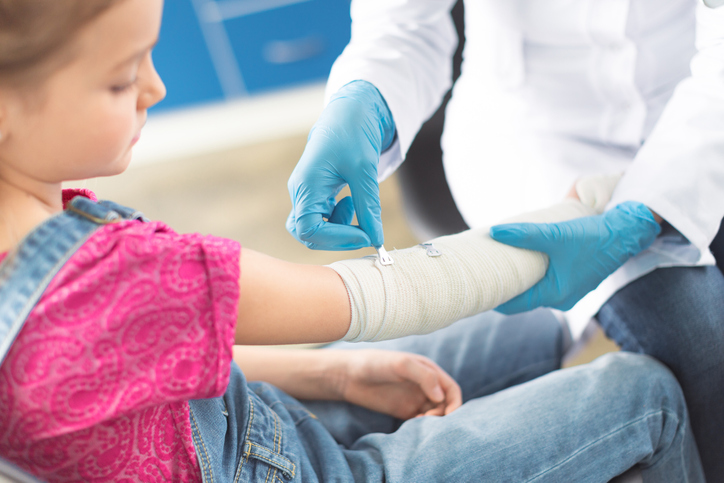
Dr. Anjan Shah, orthopedic trauma surgeon at Tampa General Hospital and with Florida Orthopaedic Institute, has dealt with countless cases like this. He’s been treating pediatric bone fractures for many years.
To read the complete story on tgh.org, click here. Full story below.
By Mike Brassfield on Friday February 24, 2017
Your child is climbing around on the monkey bars or on some elaborate piece of modern playground equipment. The kid slips and falls, plummeting to the ground with enough force to concern you.
Every parent everywhere has been in this situation: My child just crash-landed. Is he or she hurt? Are any bones broken or anything?
You rush over there. As you soothe your crying child, you inspect him or her with a keen eye. Is there any bleeding? Any cuts or bruises? Is the child complaining that something hurts? Are there any, God forbid, broken bones? Surely this won’t call for a trip to the emergency room, will it? Oh, please, no.
Dr. Anjan Shah, orthopedic trauma surgeon at Tampa General Hospital and with Florida Orthopaedic Institute, has dealt with countless cases like this. He’s been treating pediatric bone fractures for many years.
Let’s stipulate that if your child has an obvious injury – some body part is noticeably crooked or out of place – of course you’re going to seek out immediate medical treatment. That’s a no-brainer.
But what if there’s not an obvious injury? That’s where parental judgement comes into play. As a parent of two active little children, I have grappled many times with the questions that come up at times like this:
How do I know if a bone is broken? Is there something I should be looking for? When should I take my kid to the ER? Can the injury become worse if it’s not treated right away? Why is it so hard to tell a minor fracture from a sprain?
Dr. Shah has answers.
What general advice would you give parents in these kind of situations?
Trust your instincts. The majority of the time, parents are pretty good at detecting when something is wrong – when kids are showing signs that they’ve got a fracture. Most parents have a natural, innate ability to quickly gauge how serious it is.
One thing about kids is, they’re pretty resilient. We make the comment that kids bounce. And it’s true.
What signs should parents be looking for?
You should pay attention if the problem persists. If the child is still acting differently hours later, that’s a cue. If the child is still complaining about pain, or guarding (holding a hand over the injured area).
Maybe after dinner, they don’t want to play on the iPad. They just want to go to sleep. They’re not doing activities they’d normally want to do. Or they’re not using that wrist. These are all clues that it’s more serious.
What fractures do you most frequently see in children?
In the elbow, wrist and ankle. Falling from the monkey bars is a common source of elbow fractures. Or they’ll step in a hole and twist their ankle. Wrist fractures are very common because they’ll fall and use their wrists to break their fall.
With children, what kind of injury is mostly likely to go unnoticed?
The most common injuries I see missed are wrist fractures. An elbow injury is pretty obvious. If it’s a leg or ankle injury, the child’s not going to walk. With a wrist fracture, sometimes it doesn’t look bad.
Because of that, do parents ever delay bringing a child with a wrist fracture to the hospital? Does it sometimes take a day or so?
Yes. Parents usually feel pretty bad about it, but you can’t blame them. Sometimes it’s just not obvious. A kid falls off a skateboard or a bicycle, and that wrist can look okay even though there’s a fracture.
Are children’s bones different than adults’ bones?
There’s a huge difference. Adults have completely grown bones. Kids are still growing, so they have things called growth plates at the tops and bottoms of their bones. That’s where their bones are growing.
The most common pediatric fractures are growth plate injuries. That’s the weakest part of the bone. The weakest link in the chain is where the chain breaks.
What happens if a pediatric fracture isn’t treated right away?
Swelling around it can become an issue. But because kids are still growing, you can often set the bone and put it in a cast without surgery. Their bones have this remarkable ability to grow and correct themselves and get to where they need to be.
With adults, if you break your leg or your arm, you’re more likely to need surgery to get the bone back into whatever position it needs to be in.
Based on your longtime experience in emergency rooms, what else would you advise parents to keep in mind?
Children don’t need to be anywhere near a lawn mower. Those are the worst injuries I’ve ever seen.
In the car, make sure kids are wearing seat belts. Keep them in car seats. Kids have no mass in their bodies, so in an accident they’ll get launched and ejected from the vehicle. It’s devastating – and completely preventable.
